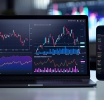
Currency vs. Stocks
In the vast realm of financial markets, two giants stand tall: currency trading and stock trading. While both avenues offer opportunities for profit and growth, they operate on fundamentally different principles and attract diverse groups of participants. Currency trading, commonly referred to as Forex (Foreign Exchange), revolves around the buying and selling of currencies. In contrast, stock trading involves purchasing shares of companies to gain ownership stakes and profit from the companies’ performance.
Understanding these two markets is crucial in today’s interconnected global economy. As technology advances and financial instruments evolve, traders and investors increasingly find themselves at a crossroads—deciding between the dynamic world of Forex or the structured environment of stock markets. This essay aims to explore the key differences between currency and stock trading by examining their market dynamics, risk factors, volatility levels, profit potential, and strategies employed by traders.
Understanding these two markets is crucial in today’s interconnected global economy. As technology advances and financial instruments evolve, traders and investors increasingly find themselves at a crossroads—deciding between the dynamic world of Forex or the structured environment of stock markets. This essay aims to explore the key differences between currency and stock trading by examining their market dynamics, risk factors, volatility levels, profit potential, and strategies employed by traders.

Currency vs. Stocks
Market Dynamics
Description of Currency Markets (Forex)
The Forex market is a decentralized global marketplace where currencies are traded 24 hours a day, five days a week. Unlike stock exchanges that have physical locations, Forex operates entirely online through a network of banks, brokers, financial institutions, and individual traders. The primary purpose of this market is to facilitate international trade and investment by enabling currency conversion.
Forex trading is known for its high liquidity due to the massive volume of transactions occurring daily—over $6 trillion as per recent estimates. Major currency pairs like EUR/USD, GBP/USD, and USD/JPY dominate the market, but numerous other pairs offer ample opportunities for traders.
Description of Stock Markets
Stock markets are centralized venues where shares of publicly traded companies are bought and sold. These markets have set operating hours corresponding to their respective time zones; for example, the New York Stock Exchange (NYSE) operates from 9:30 AM to 4:00 PM ET. Stock exchanges provide a regulated environment where companies can raise capital by issuing shares to investors who seek ownership stakes.
Participants in stock markets include individual investors, institutional investors like mutual funds and pension funds, hedge funds, and corporate insiders. Stocks are categorized into various sectors such as technology, healthcare, finance, etc., allowing investors to diversify their portfolios across different industries.
Key Differences in Market Operations
The primary distinctions between Forex and stock markets lie in their operations:Trading Hours: Forex operates continuously throughout the week due to its global nature while stocks trade during specific hours depending on the exchange.
Market Participants: Forex involves a broader range of participants including governments and central banks influencing currency values while stocks attract mainly institutional investors focused on company performance.
Instruments Traded: Forex deals exclusively with currency pairs whereas stocks involve equity shares representing ownership in companies.
Risk and Volatility
Analysis of Risk Factors in Currency TradingCurrency trading carries significant risks primarily driven by geopolitical events; economic data releases; interest rate decisions; natural disasters; political instability; speculative activity; unexpected policy changes; or unforeseen global crises can cause sharp fluctuations in exchange rates causing substantial losses if not managed properly through effective risk management techniques such as stop-loss orders or hedging strategies using derivatives like options or futures contracts…
Analysis Of Risk Factors In Stock Trading
Stock trading also presents numerous risks associated with company-specific factors including poor corporate governance practices leading towards fraud/scandals resulting into drastic decline making investments worthless overnight however some external macroeconomic conditions affect overall market sentiment adversely impacting entire portfolios hence diversification becomes essential mitigating potential losses ensuring consistent long-term returns…
Comparison Of Volatility Levels Between Currencies And Stocks
Volatility levels vary significantly between these two asset classes generally forex exhibiting higher short-term fluctuations due larger number participants engaged speculating direction exchange rates however certain stocks particularly those smaller cap firms volatile nature subject rapid movements influenced news announcements earnings reports product launches regulatory changes merger acquisitions etc while blue-chip stable predictable performance offering steady income streams dividends…
Profit Potential And Strategies
Overview Of Profit-Making Potential In Forex Trading:
Forex provides substantial profit-making opportunities leveraging small price movements using margin accounts amplifying gains although increased leverage magnifies losses careful analysis technical fundamental factors crucial develop sound strategy maximizing returns minimizing risks continuous monitoring adjusting positions necessary adapting changing conditions swiftly effectively ensuring sustained profitability…
Overview Of Profit-Making Potential In Stock Investments:
Stocks historically proven generate significant wealth appreciation value driven successful business models innovative products/services strong leadership robust financials prudent management practices consistent earnings growth dividend payments compounding effect reinvested dividends create exponential returns long term horizon patience discipline essential achieving desired outcomes avoiding impulsive decisions emotional reactions short-term fluctuations preserving capital maximizing gains sustainable manner…
Common Strategies Employed By Traders Both Markets:
Technical Analysis studying past price patterns identify trends support resistance levels predict future movements.Fundamental Analysis evaluating underlying economic indicators company financial statements assess intrinsic value.
Day Trading executing multiple trades within single day capitalize intraday price swings.
Swing Trading holding positions several days capture intermediate trends.
Position Trading maintaining long-term positions based macroeconomic outlooks industry forecasts corporate developments align investment objectives risk tolerance profiles optimize portfolio performance achieving desired outcomes efficiently effectively leveraging available resources tools technologies maximize potential minimize exposure adverse events uncertainties inherent dynamic complex environments navigating successfully realizing goals ambitions ultimately succeeding competitive challenging landscapes prevailing against odds thriving prospering…
Currency trading, Stock trading, Forex, Financial markets, Investment comparison














Report
My comments